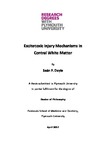Excitotoxic Injury Mechanisms in Central White Matter
| dc.contributor.supervisor | Fern, Robert | |
| dc.contributor.author | Doyle, Seán P. | |
| dc.contributor.other | Faculty of Health | en_US |
| dc.date.accessioned | 2017-07-03T14:10:55Z | |
| dc.date.issued | 2017 | |
| dc.identifier | 10488816 | en_US |
| dc.identifier.uri | http://hdl.handle.net/10026.1/9586 | |
| dc.description.abstract |
Myelinated axons are crucial for rapid information transmission within the central nervous system (CNS). Myelin injury is a common feature of white matter (WM) pathology in a number of disease states, including ischemic stroke. Myelin disruption can lead to a complete failure in saltatory action potential conduction, resulting in devastating neurological deficits. However, the fundamental mechanism of ischemic myelin injury is controversial. Glutamate-mediated excitotoxicity is now recognised as a crucial event in the development of ischemic WM pathology. This thesis investigates the potential mechanisms of glutamate release in central WM and examines the hypothesis that NMDA receptor over-activation mediates ischemic myelin damage. Using glutamate biosensor microelectrodes and FM-dye imaging, I show that axonal depolarisation in the adult corpus callosum evokes rapid vesicular docking in axons, capable of elevating extracellular glutamate concentration. My findings show that vesicular fusion occurs under the myelin sheath in myelinated axons, which supports the existence of a novel synapse between the axon and overlaying myelin. Simulation of ischemia triggered an early and robust rise in optic nerve extracellular glutamate levels. Unexpectedly, a significant component of ischemic glutamate release also originated from axonal vesicular fusion. Together, these findings show that the axon-myelin synapse represents a significant site of excitotoxic injury during ischemia. Resolving prior conflicting results, I show that NMDA receptor antagonists prevent myelin degradation and improve functional recovery when applied for sufficient time to penetrate the sheath. Finally, I identify a fluorescent myelin stain (QNZ-46) which is a negative allosteric modulator of NR2C/D-containing NMDA receptors. QNZ-46 selectively accumulates in myelinated WM regions of the CNS following systemic administration, and is retained following wash-out. As a result, QNZ-46 provides persistent protection during ischemia by preserving myelin structure and improving functional recovery. | en_US |
| dc.language.iso | en | |
| dc.publisher | University of Plymouth | |
| dc.rights | CC0 1.0 Universal | * |
| dc.rights.uri | http://creativecommons.org/publicdomain/zero/1.0/ | * |
| dc.subject | White matter | en_US |
| dc.subject | Myelin | en_US |
| dc.subject | Stroke | en_US |
| dc.subject | Glutamate | en_US |
| dc.subject | Excitotoxicity | en_US |
| dc.subject | Vesicles | en_US |
| dc.subject | Axon | en_US |
| dc.subject | Electrophysiology | en_US |
| dc.subject | Ischemia | en_US |
| dc.subject.classification | PhD | en_US |
| dc.title | Excitotoxic Injury Mechanisms in Central White Matter | en_US |
| dc.type | Thesis | |
| plymouth.version | publishable | en_US |
| dc.identifier.doi | http://dx.doi.org/10.24382/734 | |
| dc.rights.embargodate | 2018-07-03T14:10:55Z | |
| dc.rights.embargoperiod | 12 months | en_US |
| dc.type.qualification | Doctorate | en_US |
| rioxxterms.version | NA |
Files in this item
This item appears in the following Collection(s)
-
01 Research Theses Main Collection
Research Theses Main



